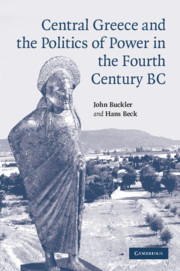Book contents
- Frontmatter
- Contents
- List of maps
- Preface
- Acknowledgments
- List of abbreviations
- Prologue
- Part I ALLIANCE
- Part II HEGEMONY
- Chapter 6 The re-establishment of the boiōtarchia (378 BC)
- Chapter 7 The battle of Tegyra, 375 BC
- Chapter 8 Plutarch on Leuctra
- Chapter 9 Alliance and hegemony in fourth-century Greece: the case of the Theban Hegemony
- Chapter 10 Xenophon's speeches and the Theban Hegemony
- Chapter 11 The phantom synedrion of the Boeotian Confederacy, 378–335 BC
- Chapter 12 Boeotian Aulis and Greek naval bases
- Chapter 13 Epaminondas and the new inscription from Cnidus
- Part III DOMINATION
- Epilogue
- Glossary
- References
- Index
Chapter 7 - The battle of Tegyra, 375 BC
from Part II - HEGEMONY
Published online by Cambridge University Press: 22 September 2009
- Frontmatter
- Contents
- List of maps
- Preface
- Acknowledgments
- List of abbreviations
- Prologue
- Part I ALLIANCE
- Part II HEGEMONY
- Chapter 6 The re-establishment of the boiōtarchia (378 BC)
- Chapter 7 The battle of Tegyra, 375 BC
- Chapter 8 Plutarch on Leuctra
- Chapter 9 Alliance and hegemony in fourth-century Greece: the case of the Theban Hegemony
- Chapter 10 Xenophon's speeches and the Theban Hegemony
- Chapter 11 The phantom synedrion of the Boeotian Confederacy, 378–335 BC
- Chapter 12 Boeotian Aulis and Greek naval bases
- Chapter 13 Epaminondas and the new inscription from Cnidus
- Part III DOMINATION
- Epilogue
- Glossary
- References
- Index
Summary
The battle of Tegyra has seldom received systematic treatment, with the notable exception of W. K. Pritchett's study. That is hardly surprising, for it was little more than a skirmish that goes unmentioned even in Nepos' sketch of Pelopidas' life. Nevertheless, other scholars have used the episode to determine the sources used by Plutarch, the major authority on it, in his composition of the Life of Pelopidas. More voluminous is the literature on the site of the battle and the topography of the battlefield. The battle, despite the small numbers involved, also provides an additional point of interest regarding what Plutarch could add from his own knowledge to his narrative. He had himself seen Tegyra and thus enjoyed the opportunity to compare his observations with the testimony of earlier historians.
The history of Boeotia between the liberation of the Cadmea in 378 and the battle of Tegyra in 375 is one of innumerable and sometimes desultory campaigns and raids. For the most part, the Spartans placed garrisons in strategically important cities, notably Tanagra, Plataea, Thespiae, and Orchomenus, from which the Thebans attempted to dislodge them. Orchomenus was the most dangerous point because of its natural strength, the hostility of its inhabitants to Theban hegemony of Boeotia, its easy communications with neighbouring Phocis, and the facility with which the Spartans could push reinforcements across the Corinthian Gulf to Cirrha and thence to Orchomenus. Aware of these dangers, Pelopidas long awaited the opportunity to assail Orchomenus at a moment's notice (Plut. Pel. 16, 2).
- Type
- Chapter
- Information
- Publisher: Cambridge University PressPrint publication year: 2008

